January 2025
The global biodegradable mulch film market size is accounted at USD 54.99 billion in 2025 and is forecasted to hit around USD 111.95 billion by 2034, representing a notable CAGR of 8.22% from 2025 to 2034. The Asia Pacific market size was estimated at USD 31.50 billion in 2024 and is expanding at a CAGR of 8.30% during the forecast period. The market sizing and forecasts are revenue-based (USD Million/Billion), with 2024 as the base year.
The global biodegradable mulch film market size was calculated at USD 50.81 billion in 2024 and is predicted to increase from USD 54.99 billion in 2025 to approximately USD 111.95 billion by 2034, expanding at a CAGR of 8.22% from 2025 to 2034. Rising demand and need for food crops across the globe are the key factors driving market growth. Also, the surging demand for sustainability solutions in agricultural practices coupled with the promotion activities done by governments and other organizations to support biodegradable options can fuel market growth further.
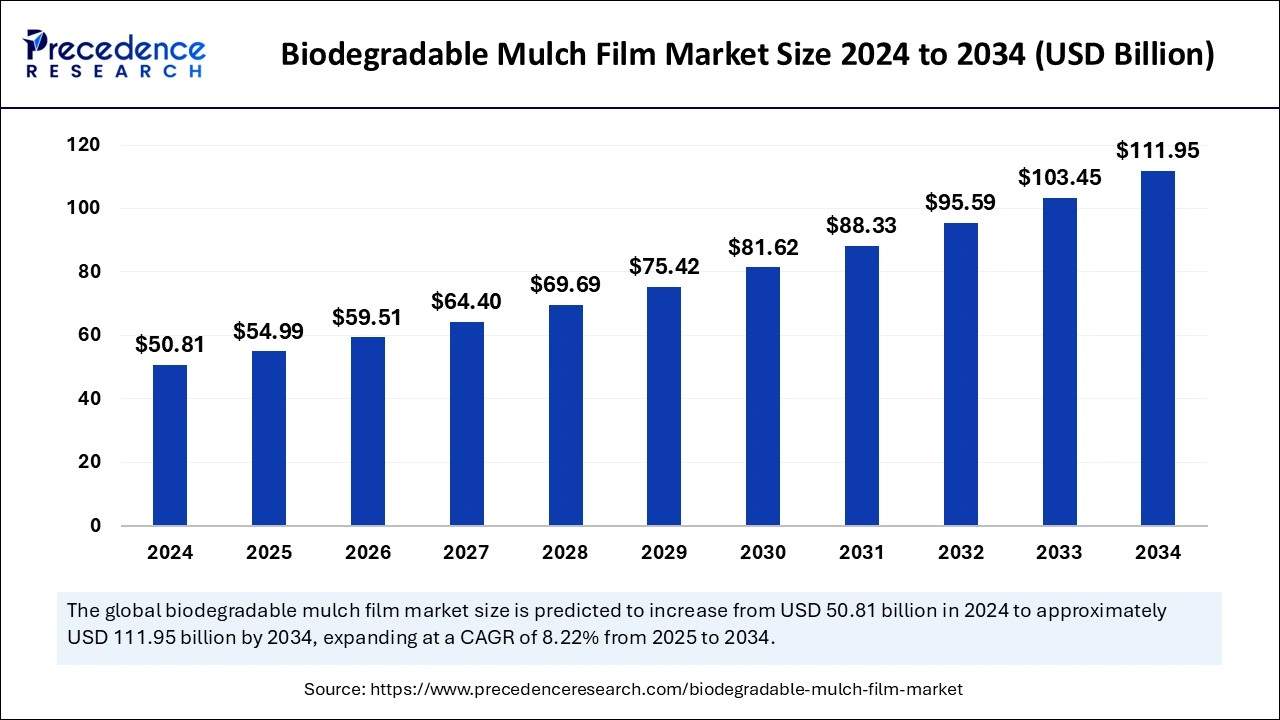
In the biodegradable mulch film market AI-driven systems enable easy weather predictions, assess farms, and control and monitor agricultural sustainability technology using data such as precipitation, temperature, sun radiation, and wind speed in combination with photographs taken by drones and satellites. Furthermore, artificial intelligence systems can assist farmers in regulated and precision farming by offering them the correct advice on crop rotation, water management, optimal planting, pest attacks, and timely harvesting.
The Asia Pacific biodegradable mulch film market size was exhibited at USD 31.50 billion in 2024 and is projected to be worth around USD 69.97 billion by 2034, growing at a CAGR of 8.30% from 2025 to 2034.
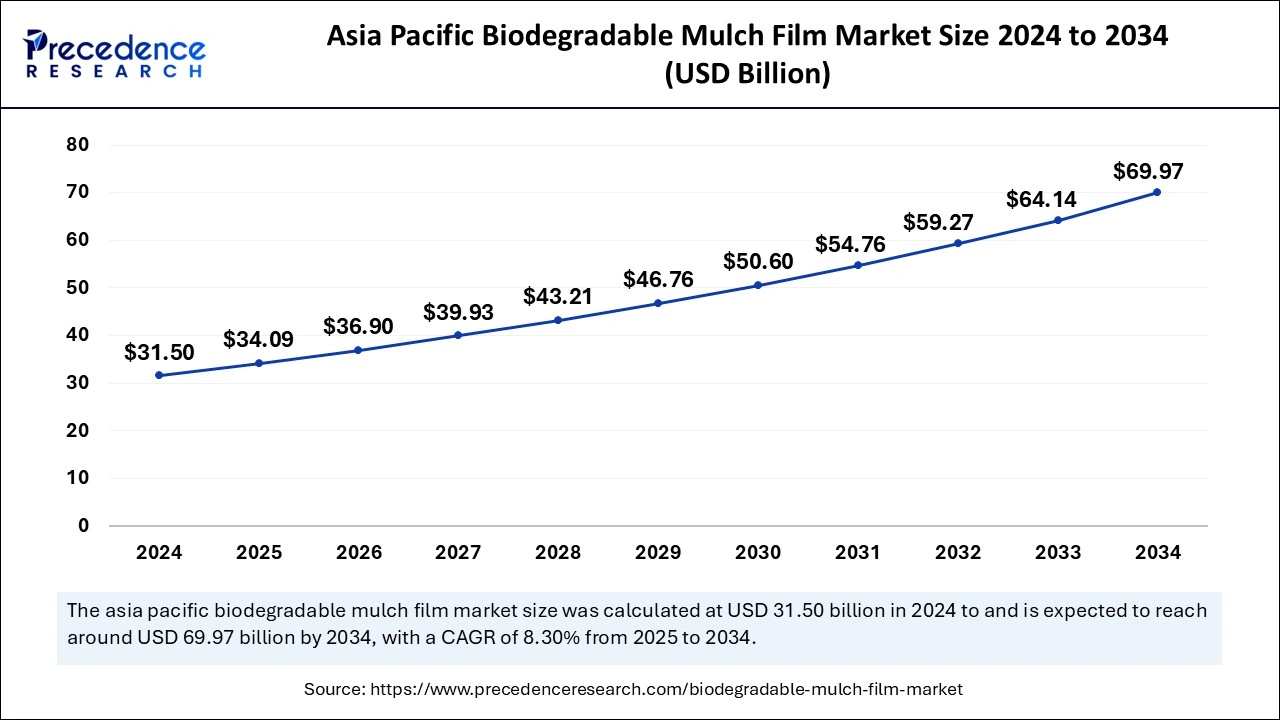
Asia Pacific dominated the global biodegradable mulch film market in 2024. The dominance of the region can be attributed to the ongoing expansion of the agriculture industry coupled with the increasing emphasis on eco-friendly farming practices. Emerging economies in this region, such as Thailand, India, and Vietnam, are huge agricultural producers and sometimes confront hurdles with soil degradation because of wide plastic mulch use. Furthermore, the governments of major countries in the region are focusing on promoting sustainable agriculture and environmental conservation initiatives.
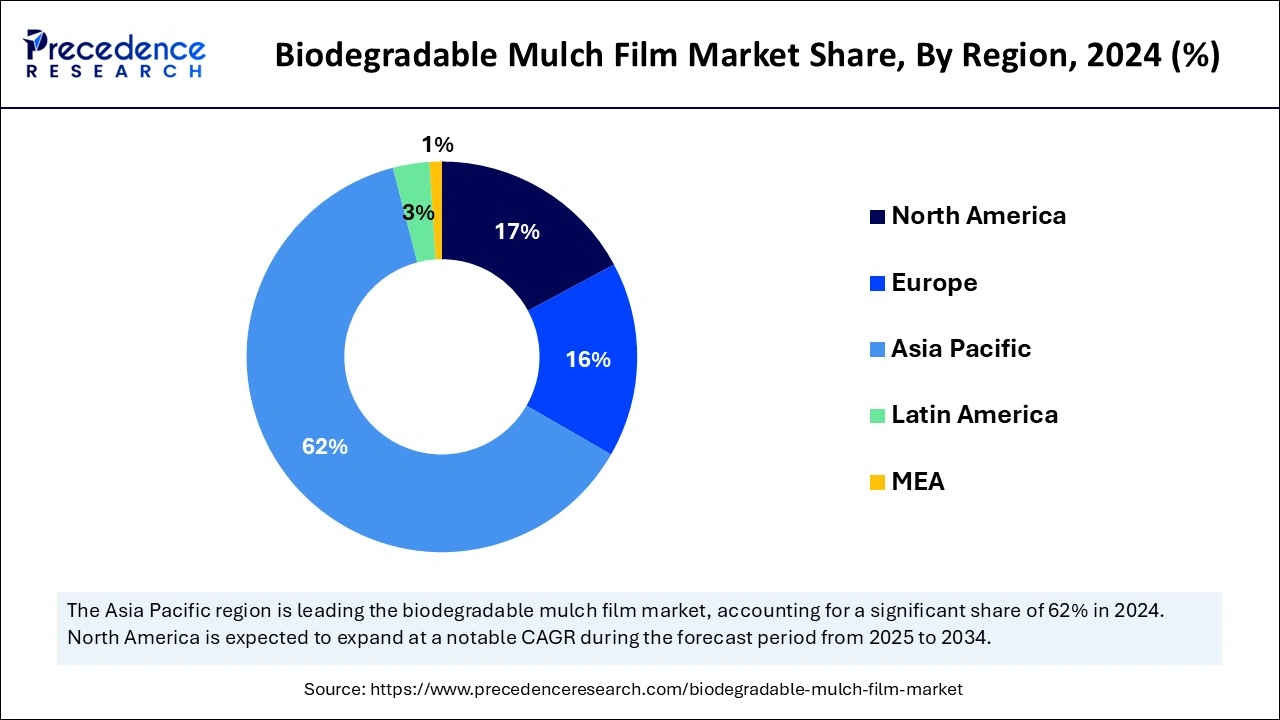
North America is expected to grow at the fastest rate in the biodegradable mulch film market over the studied period. The growth of the region can be credited to the strict government laws on plastic usage in the agriculture sector and increasing environmental awareness, which are the major market drivers in the region. Within North America, the U.S. led the market owing to the combination of environmental policy initiatives and demand to safeguard soil health. As a prominent player in agricultural production, the U.S. is taking steps to decrease plastic waste in farming.
Biodegradable mulch films are materials derived from animals and plants, giving benefits like maintenance of soil structure, weed control, and protecting crops from soil contamination. These films are a more sustainable and convenient alternative to conventional plastic mulch, raced from decomposable raw materials. The films are mainly used in agricultural practices to improve crop yields and retain soil moisture while providing the benefit of cutting the requirement for film removal after harvest.
Top 5 wheat exporters by country in 2023
| Country | Export amount |
| Russia | USD 9.5 billion |
| Australia | USD 9.33 billion |
| Canada | USD 8.8 billion |
| United States | USD 6.1 billion |
| France | USD 4 billion |
| Report Coverage | Details |
| Market Size by 2034 | USD 111.95 Billion |
| Market Size by 2025 | USD 54.99 Billion |
| Market Size in 2024 | USD 50.81 Billion |
| Market Growth Rate from 2025 to 2034 | CAGR of 8.22% |
| Leading Region | Asia Pacific |
| Fastest Growing Market | North America |
| Base Year | 2024 |
| Forecast Period | 2025 to 2034 |
| Segments Covered | Polymer, Application, and Regions |
| Regions Covered | North America, Europe, Asia-Pacific, Latin America, and Middle East & Africa |
Surge in growth of the horticulture sector
The ongoing growth of the horticulture sector is the major factor driving the growth of the biodegradable mulch film market. The rising emphasis of the horticulture sector on efficient and eco-friendly production methods aligns smoothly with the advantages provided by biodegradable mulch film. In addition, increasing technological advances in farming, along with the strict government regulation on the use of biomaterials.
High biodegradable films cost
The high cost of these films is the primary factor hampering the biodegradable mulch film market growth. This high cost of films is due to the costly raw materials used in their manufacturing and the tedious production processes involved. Moreover, the inconsistent performance of these films because of frequently changing environmental conditions can lead to cost fluctuation and hence limit their ability, affecting their widespread application in many areas.
Innovations in biodegradable polymer technology
The biodegradable mulch film market is majorly influenced by substantial developments in biodegradable polymer technology. The R&D in this field is fuelling the creation of more effective, durable, and cost-effective biodegradable mulch films. Furthermore, the latest biodegradable films are created to provide the same advantages as traditional plastic films, like flexibility, strength, and water permeability, by ensuring total biodegradability. Advancements in the manufacturing process are decreasing the cost of biodegradable films.
The thermoplastic starch (TPS) segment dominated the biodegradable mulch film market in 2024. The dominance of the segment can be attributed to the increasing environmental concerns about the utilization of traditional synthetic polymers in the manufacturing of agricultural films, which have shifted the trend towards the adoption of biodegradable materials. Additionally, thermoplastic starch decomposes into harmless substances when placed in soil. Strict government regulations promoting sustainable packaging solutions can propel the segment.
The starch blended with polylactic acid (PLA) segment led the market in 2024. The growth of the segment can be credited to the surging consumer awareness, government incentives, and the extensive availability of raw materials. PLA is also created chemically by treating starch and sugar. PLA can be processed using ordinary equipment. Moreover, the use of starch in PLA can substantially improve certain properties, like barrier attributes and stiffness, which makes the blend more sophisticated for an extensive range of applications in agriculture.
In 2024, the fruits and vegetables segment led the biodegradable mulch film market by holding the largest share. The dominance of the segment can be linked to their capability to protect weed growth, improve soil temperature, and conserve soil moisture, which enhances fruit and vegetable quality and increases yield performance. Furthermore, rising demand for organic and eco-friendly produce fuels the adoption of these films in this segment, which aligns with consumer preferences for sustainably responsible farming initiatives.
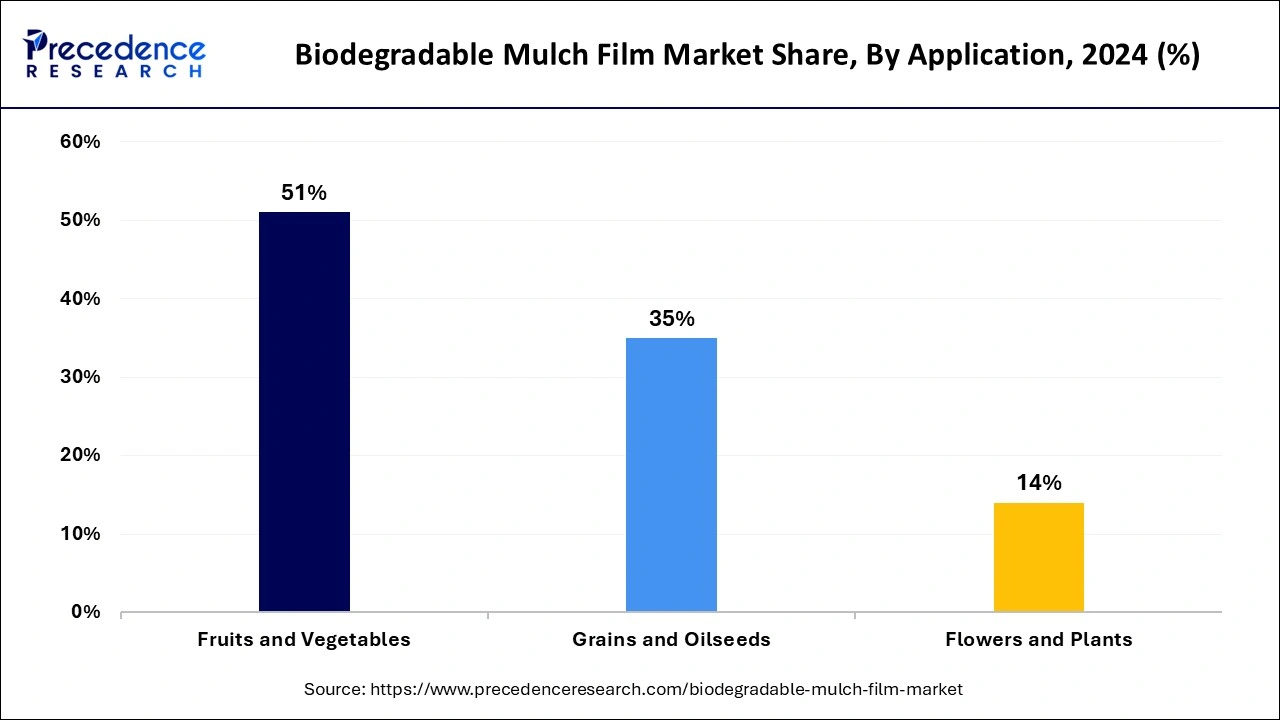
The grain and oilseeds segment is expected to grow at the fastest rate during the projected period. The growth of the segment is driven by rising awareness of environmentally friendly agricultural practices and soil conservation. Grains and oilseeds, like wheat, corn, and soybean, are major crops in widely cultivated areas across the globe. Also, these films in the segment help in weed control and moisture retention, which contributes to stronger and higher crop yields and decreases agricultural waste.
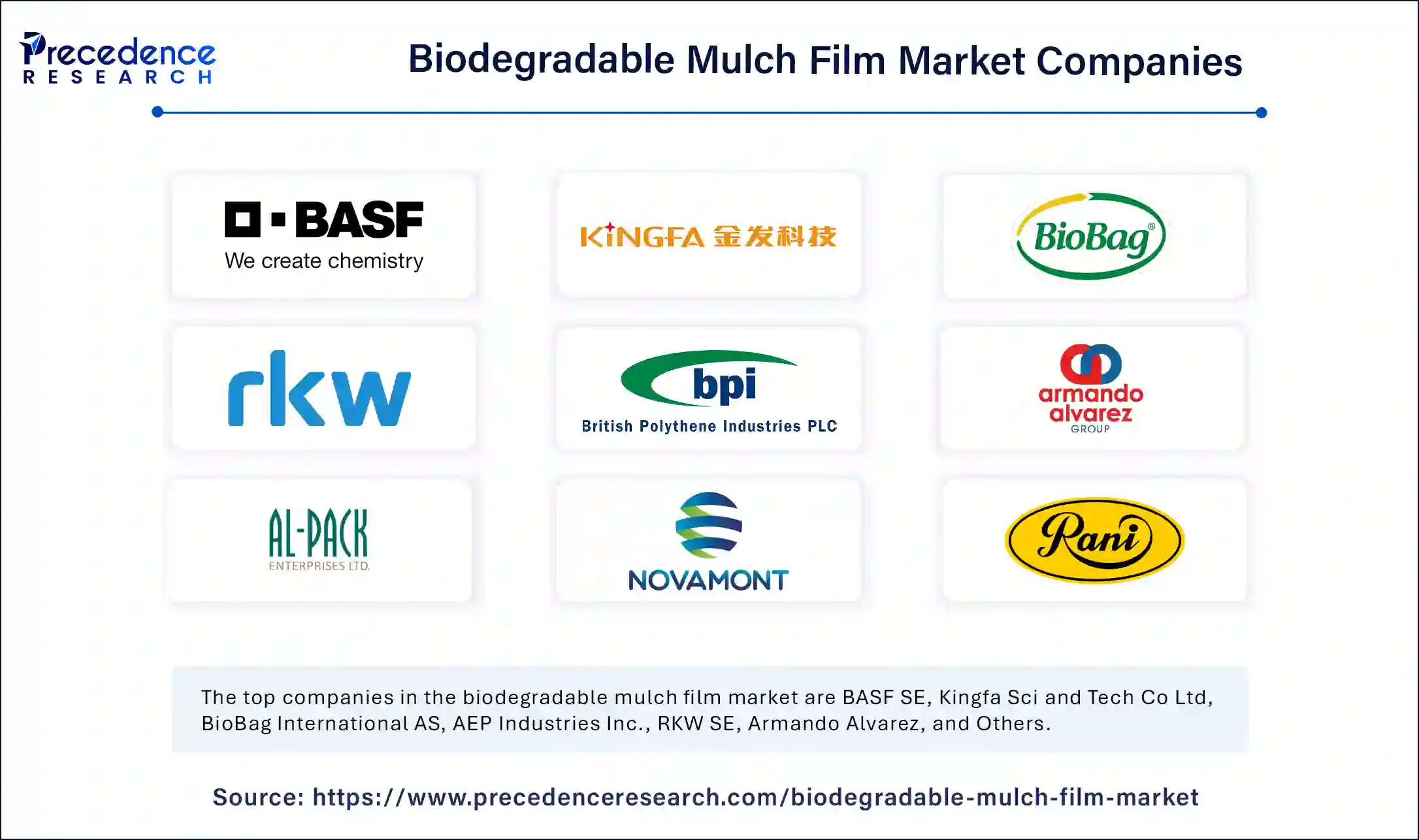
By Polymer
By Application
By Geography
For inquiries regarding discounts, bulk purchases, or customization requests, please contact us at sales@precedenceresearch.com
No cookie-cutter, only authentic analysis – take the 1st step to become a Precedence Research client
January 2025
February 2025
October 2024
May 2024